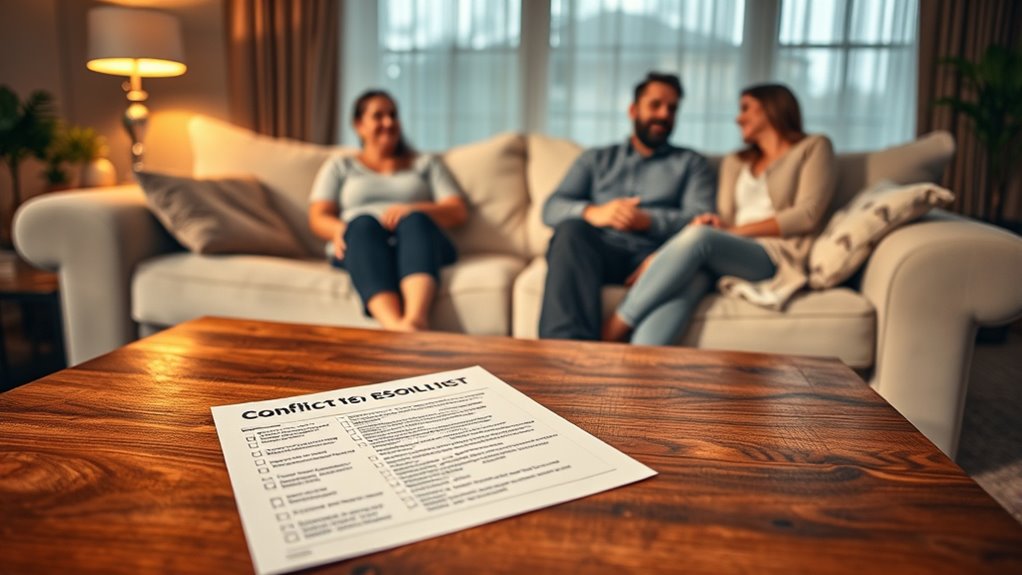Having a conflict-resolution checklist printable is a smart move for couples who want to handle disagreements thoughtfully. It helps you stay focused on effective communication, emotional awareness, and respectful problem-solving. By keeping this handy, you can prevent small disputes from escalating while fostering understanding and connection. With consistent use, you’ll improve your responses and create healthier conversations. Stay with us to discover how this simple tool can transform your relationship dynamics even further.
Key Takeaways
- Use effective communication strategies like active listening, eye contact, and calm tone to de-escalate conflicts.
- Recognize and understand your own emotions and triggers to respond thoughtfully rather than react impulsively.
- Express feelings with “I” statements and acknowledge your partner’s emotions to foster safe, constructive dialogue.
- Employ conflict management techniques such as paraphrasing, taking breaks, and revisiting issues when calmer.
- Keep a printed checklist handy, practice emotional awareness, and focus on empathy to turn disputes into growth opportunities.

Conflict is inevitable in any relationship, but how you handle it can make all the difference. When disagreements arise, your ability to communicate effectively and stay emotionally aware determines whether you resolve issues or let them fester. Developing solid communication strategies is essential. This means actively listening to your partner without interrupting, making eye contact, and showing genuine interest in understanding their perspective. Avoid jumping to conclusions or dismissing their feelings—acknowledging their emotions helps create a safe space for dialogue. Remember, communication isn’t just about what you say; it’s also about how you say it. Using a calm tone, maintaining open body language, and choosing your words carefully can prevent conflicts from escalating.
Effective communication and emotional awareness are key to resolving conflicts and strengthening your relationship.
Equally important is emotional awareness. Recognizing your own feelings and understanding what triggers your reactions give you better control over your responses. When you’re emotionally aware, you’re less likely to lash out or withdraw, and more apt to approach conflicts with empathy. Before engaging in a difficult conversation, pause to identify what you’re feeling—anger, frustration, disappointment—and consider why you feel that way. This self-awareness helps you communicate your needs clearly without blame or accusations, which can make your partner feel attacked instead of understood. It also allows you to tune into your partner’s emotional cues, picking up on subtle signs that they’re upset or overwhelmed, so you can address issues before they escalate. Developing emotional awareness can also help you interpret non-verbal signals, reducing misunderstandings during disputes.
A useful conflict-resolution checklist should include steps like taking deep breaths before responding, ensuring you’re calm and centered. When you’re emotionally aware, you recognize that your feelings are valid but don’t have to control your actions. Use “I” statements to express your feelings without sounding accusatory—for example, “I feel hurt when…” rather than “You always…” This approach fosters a more constructive exchange. During the conversation, prioritize clarity over defensiveness. Confirm what you’ve heard by paraphrasing your partner’s points, which shows you’re actively engaged and trying to understand. If emotions run high, agree to take a break and revisit the discussion once everyone has cooled down. This prevents rash words and helps maintain respect.
In the end, effective communication strategies paired with emotional awareness pave the way for healthier conflict resolution. They enable you to navigate disagreements with empathy and clarity, strengthening your connection rather than tearing it apart. Keeping these principles in mind, and perhaps printing out a conflict-resolution checklist, gives you a practical tool to refer to in tense moments. It’s a reminder that how you handle conflict is within your control—and with practice, you can turn disputes into opportunities for growth and understanding.
Frequently Asked Questions
How Often Should Couples Review Their Conflict-Resolution Checklist?
You should review your conflict-resolution checklist regularly to keep communication fresh and effective. Ideally, do a quick emotional check-in and communication refresh once a month or whenever you notice tension rising. This way, you stay aligned and prevent small issues from escalating. Regular review helps you both stay mindful of your conflict strategies, ensuring you’re always prepared to handle disagreements constructively and strengthen your relationship over time.
Can This Checklist Be Adapted for Long-Distance Relationships?
Did you know 60% of long-distance couples report stronger emotional connections? You can adapt your conflict-resolution checklist by emphasizing effective long-distance communication techniques. Focus on active listening, clear expression of feelings, and regular video calls. This way, you bolster your emotional bond despite the miles apart. Tailoring your approach helps ensure misunderstandings are minimized, and your relationship remains resilient and connected, even across great distances.
What if One Partner Refuses to Use the Checklist?
If your partner refuses to cooperate with the checklist, don’t assume it’s a personal attack. Instead, focus on understanding their reasons and try introducing alternative conflict strategies. You can suggest different approaches, like talking calmly or taking breaks, to help them feel more comfortable. Remember, refusal to cooperate isn’t the end; it’s an opportunity to explore other effective ways to resolve conflicts together.
Are There Specific Conflicts Best Addressed With This Checklist?
You might find this checklist especially helpful when facing conflicts involving communication barriers or emotional triggers. It guides you to pause, listen, and express yourself calmly, preventing misunderstandings. While some disagreements may need more personalized approaches, this tool helps you navigate sensitive issues with patience. It’s not a one-size-fits-all, but it’s a valuable starting point, ensuring you handle conflicts thoughtfully and reduce emotional escalation.
How Can Couples Ensure the Checklist Remains Effective Over Time?
To keep your conflict-resolution skills sharp, you should regularly revisit your checklist, ensuring it supports trust building and emotional intelligence. Make it a habit to discuss improvements with your partner, reflecting on past conflicts and adjusting strategies as needed. By staying committed and open-minded, you foster a healthy dynamic that adapts over time, strengthening your relationship and making the checklist a lifelong tool for effective communication.
Conclusion
By following this conflict-resolution checklist, you’ll become the superhero of your relationship, saving every argument from turning into a catastrophe! Imagine turning small disagreements into opportunities for epic understanding and love so strong, even superhero capes would envy it. Print this out, keep it handy, and watch as your conflicts shrink to tiny blips in your happily ever after. Because with this checklist, you’re not just resolving fights—you’re conquering the universe of love!









